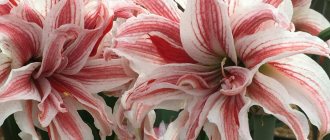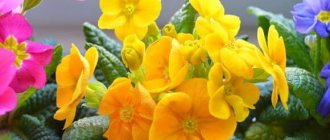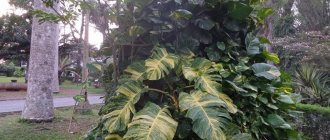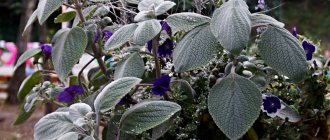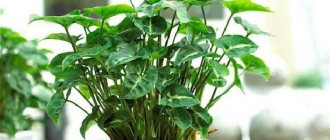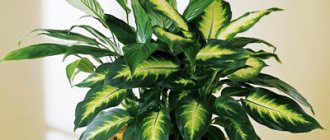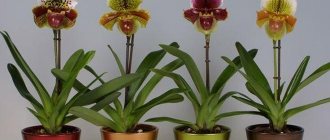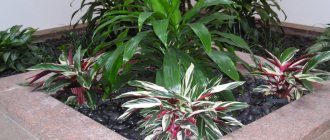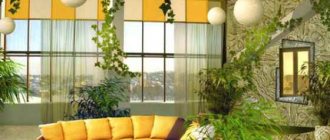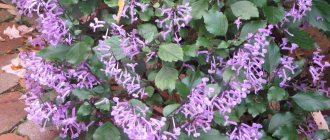Planks are often called the most ancient and one of the most “strange” indoor plants. Selaginella are grown both in pots and as luxurious miniature ampels. These ancient beauties captivate with their delightfully noble palette and texture of lacy, original dissected foliage in rugs and pillows, the density of which is difficult to compete with other indoor ground covers. The beauty of this plant's greenery has earned it a reputation as the most spectacular of carpet plants that can grow in pots.
Selaginella. © floradania
A plant with an impeccable reputation
The houseplant selaginella (selaginella) from the family of the same name, which is known to many under the common name club moss, and popular among amateur gardeners as “carpet ferns”, is the only surviving representative of the club moss, the oldest group of plants from the prehistoric era. Selaginella are rightly called “fossil” plants; their history dates back hundreds of millions of years. But despite their antiquity, in indoor culture they are rightfully classified as a group of exotics, and even moisture-loving exotics.
Selaginella are herbaceous perennials with creeping or erect shoots, much of the growth form of which is surprising. Adult selaginella will not exceed 10 cm in height, although, unlike indoor forms, natural ones can grow up to several meters. Root outgrowths extend from the shoots of the club moss. Unusual small leaves and density of growth at first glance make it possible to recognize that the plant belongs to the most ancient cultures of the prehistoric period.
Selaginella are tropical and subtropical exotics capable of forming carpet-like, amazingly dense and spectacular thickets, with unusual greenery that is somewhat reminiscent of coral. The leaves of club mosses are very small, flat, in diameter they do not exceed 0.5 cm, but thanks to their two- or four-row arrangement and tiled pattern, they form stunningly beautiful fronds, which indeed externally evoke associations either with corals, or with conifers or fronds of ferns . The openwork pattern turns the rugs into luxurious green lace, which you can admire endlessly. Depending on the species and variety, the soft-to-touch foliage of Selaginella can be either the brightest or darkest or lightest, green or almost blue, glossy or matte, with uniform color, subtle variegated patterns or watercolor transitions from light to dark.
Selaginella. © floradania
The originality of Selaginella as an indoor culture
When you become interested in growing selaginella at home, at the stage of searching for information about the plant, a situation awaits you: “it’s not clear what it is and where it comes from.” You may come across many common names for the plant, which confuse everything even more. For example, “moss fern” is a name that will make even the most stern botanist smile. Selaginella is not an algae, not a moss, not a fern.
Features of Selaginella:
- The genus Selaginella (Russian synonym Plaunok) is the only one in the family Selaginellaceae of the Mossidae department.
- The oldest spore plants, “living fossils”, which are 410 million years old, are contemporaries of dinosaurs.
- Perennial ground cover herbs with erect or creeping shoots covered with small leaves that make Selaginella look like tiny ferns, junipers, and thuja.
- They grow slowly, so the height of adult specimens in indoor culture rarely exceeds 15 cm.
- They differ from real mosses by the presence of scaly leaves with a tongue (microphylls), two types of spores (mega and micro).
- Megaspores develop into female gametophytes, microspores into male gametophytes.
- They do not bloom, do not produce fruits or seeds.
Selaginella are valued for their dense “cushion” growth and beautiful evergreen foliage. Varieties with variegated colors look especially elegant and original.
The origin and color of the foliage influence care, but in general, many Selaginella require the same conditions as indoor ferns.
Selaginella species
Selaginella can boast a wide variety of varieties. But out of more than 300 natural species, only about 25 varieties are grown in indoor and greenhouse culture. Almost two dozen of them are rare plants, while only 6 species of Selaginella have become widespread in private collections and among ordinary gardeners:
- The most popular of all indoor selaginella species is rightly called Selaginella martensii . A spectacular ground cover with a maximum height of 30 cm captivates with the beauty of its lacy, dense greenery and tiny leaves that form amazingly beautiful patterns on the shoots. This selaginella stands out with straight branches that lie down only over time, releasing aerial roots. The shoots look like fronds of ferns or corals, the leaves are small and bright green. There is a separate whitish-silver form of watsoniana (although only the tips of its stems are painted white).
- Selaginella kraussiana produces much longer shoots, up to 25-30 cm, flexible, producing root shoots and creating unusual carpets.
- Selaginella uncinata flaunts a luxurious dove-blue color of lacy greenery, which seems truly precious due to the very dense arrangement of “fluffy” shoots in the turf and miniature needle-like leaves.
- Selaginella willdenowii , unlike other species, develops bush-like, its shoots are densely branched, flat, smooth, dotted with thin leaves. The nature of branching and foliage resembles the branches of coniferous plants in miniature. This species is most often grown in ampels. The bright green color of the shoots themselves is intricately combined with the blue tone of the leaves.
- Selaginella apoda is the lowest type of selaginella, forming a dense, squat carpet, in which not shortened shoots, but leaves spread across the soil. This is a mossy plant with dense turf, which is suitable for ampels.
- The strangest and most unusual of all ground cover indoor plants is Selaginella lepidophylla. This selaginella is usually sold in the form of a dry ball, which literally comes to life and opens in water. A seemingly dried out, discolored, absolutely lifeless plant, when immersed in water, is magically transformed and becomes fresh, green and amazingly beautiful. At low air humidity, this beauty turns into a dry ball very quickly: shoots up to 10 cm long bend, twist, and the plant seems to close and curl up, forming a sphere. For its ability to transform after complete drying, the scaly-leaved selaginella received the nickname “Rose of Jericho” or “resurrection plant.”
- Swiss Selaginella (Selaginella helvetica) forms loose turf from serpentine thin branches densely covered with curly leaves. The leaves are arranged in a strict order, making the pattern of the curtain seem strikingly graphic. This selaginella is distinguished by its lighter color and leaves perpendicular to the shoots.
Selaginella practically do not change throughout the year and there is no pronounced period of rest in their development. Selaginella are often grown not as ordinary houseplants, but in terrariums, flower displays, florariums, indoor greenhouses, greenhouses, winter gardens and even bottle gardens. These ancient plants prefer conditions of high humidity and are most often included in special collections of tropical exotics, plants with a common habitat, and exhibitions of rare crops.
Caring for selaginella at home
Selaginella are suitable only for experienced gardeners who want to grow collections of rare plants with unusual, difficult-to-recreate conditions. But the most common species, with good care, can also be grown as ordinary indoor plants. The main difficulty is ensuring a comfortable humidity level for both the substrate and the air. It is impossible to grow this indoor crop without the most careful and attentive care. But apart from humidity, there is no need to recreate any difficult conditions for Selaginella; it is not demanding in terms of lighting or temperature conditions.
Selaginella martensii. © Alice Chodura
Selaginella uncinata. © Evan Chak
Selaginella willdenowii. © Pete The Poet
Lighting for selaginella
This ancient indoor dwarf with a special appearance is rightfully ranked among the most light-friendly indoor plants. All Selaginella can be grown with equal success in bright natural and artificial light. At the same time, the degree of illumination within the comfortable parameters does not affect the attractiveness of greenery. In indoor culture, Selaginella cannot be considered a shade-tolerant crop; they do not tolerate dense shade, but they thrive in any light from light partial shade to diffusely bright locations. Selaginella do not like direct sunlight; plants need to be protected from it with special screens or placed inside the interior.
One of the main advantages of Selaginella is that they tolerate fluctuations and changes in lighting well, do not need to compensate for the seasonal reduction in light in winter and maintain stable conditions with additional lighting.
Comfortable temperature conditions
In order to succeed in growing selaginella, it is necessary to strictly control the air temperature. All club mosses love stable temperature conditions in the range from 18 to 20 degrees Celsius. Short-term drops or increases in temperature are not scary for them, but both heat and cool conditions always affect the decorativeness of the foliage. The minimum permissible temperature is 12 degrees.
Selaginella does not tolerate even the slightest drafts even in warm seasons. It is better to protect these plants from air currents when ventilating the room, and place them in the most comfortable, stable, protected locations. Moreover, you can’t take the plunkies out into the fresh air.
Selaginella kraussiana. © Megan Hansen
Selaginella apoda. © Francis Ackerley
Swiss Selaginella (Selaginella helvetica). © Vojtěch Zavadil
Watering and air humidity
In nature, Selaginella can grow both under normal conditions and in swampy, waterlogged soil, and even tolerate complete immersion in water. But in indoor culture, ancient ground covers practically lose their adaptability to conditions of varying humidity. They are still moisture-loving plants, but they are becoming sensitive crops to the level of substrate moisture, intolerant of waterlogging and dampness as well as excessive drying of the substrate.
Finding the optimal humidity regime for all club mosses is not so easy. The soil in the pots should remain slightly moist; the top, but not the middle, layer of soil should dry out between waterings. In order to provide the best maintenance for these plants, it is necessary to use all the properties of their branched, dense and unusual root system, thanks to which Selaginella are able to independently regulate the degree of humidity of the substrate. This is very simple to do: it is better to replace classic watering for club moss with bottom watering or growing in containers with an automatic watering function and double pots. Since the plants themselves will determine the level of humidity that is comfortable in specific conditions, you will eliminate the risk of stagnation of water in the substrate or complete drought.
It is very important to select the right water for watering Selaginella. For these plants, you can only use soft water that has settled for at least 2-3 days. Moreover, water of the same characteristics should be used for both watering and spraying plants.
In contrast to moderate soil moisture, Selaginella prefer the highest possible air humidity. You need to provide them with as tropical conditions as you can. Indicators from 80% are considered the most comfortable for these plants. Humidity is maintained either by spraying the bushes up to 3 times a day, or by single spraying, supplemented by installing trays with wet moss, expanded clay, pebbles or special humidifier devices.
Selaginella lepidophylla. © Christopher
Fertilizers for selaginella
Selaginella only need fertilizer during the warmer months, when plants are more actively growing new foliage and light remains more intense. In spring and summer, for ancient ground covers, it is recommended to use a standard feeding scheme with procedures once every 2 weeks. Selaginella is characterized by a reduced need for nutrients, so the dose of fertilizer recommended by the manufacturer is always halved.
Special fertilizers for decorative deciduous crops with a high nitrogen content are best suited for club mosses.
Transplantation, containers and substrate
For this plant, substrates specific in composition should be selected. A soil mixture with neutral acidity, pH values from 5.0 to 6.0, consisting of equal parts of leaf soil, sand and peat is best suited for Selaginella. The addition of chopped moss is also required for them. But the main thing is that the soil retains moisture well, remaining light and loose.
Unlike most indoor crops, slow-growing selaginella need replanting not annually, but approximately once every 2 years. The need for replanting is signaled by complete filling of the soil in a horizontal plane, hanging leaves and shoots along the edge of the pot. The best time is early spring.
Plant replanting should be carried out according to the principle of specific partial replacement of soil. After the plants are taken out of the old container, very carefully remove the bottom layer of the substrate, trying not to touch even the slightest roots. Selaginella's root system is small, but dense and highly branched, forming a kind of dense turf, reminiscent of garden grass lawns. And the less contact with the roots, the better the club moss will tolerate the transplantation procedure. For this crop, very high drainage is placed at the bottom of the container, which should occupy up to 1/3 of the height of the pot.
Containers for selaginella are also selected according to rather unusual principles. They must be wide, but not high, and not too spacious, enough for Selaginella to take over the entire horizontal plane in 2 years. But this plant allows you to select even containers of unusual shapes and styles (provided there are good drainage holes)
Dried Selaginella martensa. © Noelia V.
Selaginella diseases and pests
With the right maintenance regimen, Selaginella can become an almost invulnerable houseplant, resistant to pests and diseases even when its “neighbors” are sick. But if you violate at least one of the principles of caring for this crop, it can suffer greatly from spider mites and other pests that breed in conditions of low air humidity. Overmoistening of the soil always leads to the spread of rot.
Common problems in growing club mosses:
- the leaves dry out, curl, become too sparse, turn pale, and the shoots become elongated when there is insufficient lighting or when grown in too dense shade;
- plant growth is practically absent or slowed down with insufficient levels of fertilizing;
- leaves turn pale and discolored when exposed to direct sunlight;
- greenery curls, curls or becomes deformed due to constant drafts;
- leaves become soft if the substrate is chosen incorrectly or the soil is too dense;
- blackening and dying of leaves is observed in club mosses that are in too hot conditions
Selaginella. © Aaron Matsumoto
Possible diseases and problems
If the plant is watered very rarely , then it may be attacked by spider mites. To combat, the leaves are wiped with a solution of soap, and then sprayed with Actellik solution, pouring 1-2 ml of Actellik into 1 liter of water.
Possible problems when growing:
- If the foliage clumps and dries out, increase the humidity.
- If the stems become elongated, then the crop does not have enough lighting.
- When the temperature is too high, the leaves become dark and fall off.
- From lack of light or due to hard water, the leaves lose their brightness.
- The plant does not grow at all due to lack of fertilizer or if the container is too small.
- Due to stagnation of moisture and the cessation of oxygen supply to the roots, the leaves wither and become soft.
In general, if you water and spray selaginella in time, this plant will delight the owner for many years.
Reproduction of Selaginella
Selaginella form spores on leaves like ferns. But they can only propagate plants in industrial conditions, because the process itself is very complex and requires additional technological processing. For indoor crops at home, the only propagation method considered acceptable is separation during transplantation.
Every two years, when all the Selaginella are transferred to new containers and the substrate is changed, the dense bushes of this plant can be divided into separate sections, which can be easily rooted provided that the substrate’s moisture content is maintained stable and air humidity is high. In this case, you can separate not even parts of the turf, but segments of rhizomes only about 5 cm long and planting them from 5 pieces in one container. Of course, it’s easier to just divide a large bush into 2-3 smaller plants. The larger the sections, the better, but small sections of club mosses adapt well.
Possible problems during cultivation
Selaginella are resistant to many tropical plant diseases. This indoor flower is more sensitive to errors in care.
- Too much sun causes burns on the leaves. You need to find the right place for the plant.
- Excessive watering leads to the formation of mold on the surface of the substrate in the pot. We remove dry, limp parts of the plant and reduce watering. If these measures do not help, then we use a more radical method - transplanting into fresh soil.
- Yellowing of the leaves of the club moss is due to lack of water. We increase watering, use water slightly warmer than room temperature.
- Drying leaf tips are a sign of dry air. It’s time for the plant to “move” to the aquarium.
